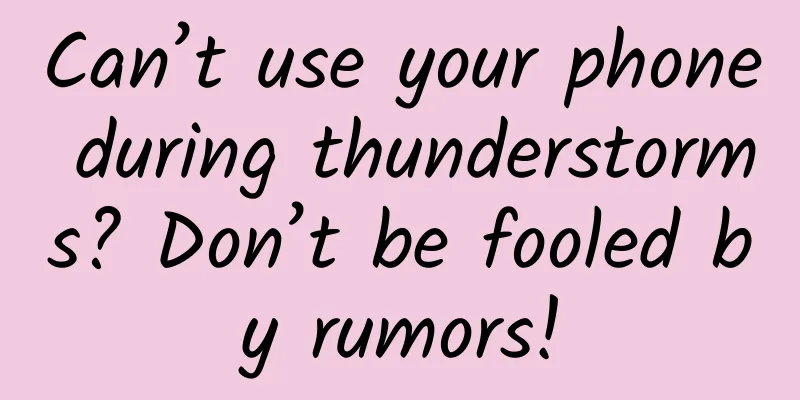Can’t use your phone during thunderstorms? Don’t be fooled by rumors!

|
Produced by: Science Popularization China Produced by: Duck Science Producer: Computer Network Information Center, Chinese Academy of Sciences Have you ever been advised by your family or friends in front of the screen: "If it's raining and thundering, don't play with your phone, or it will attract lightning!" I don't know when it started, but it has become a common "rainy day common sense" to not use mobile phones during thunderstorms, along with turning off electrical appliances and staying away from lightning rods. When surfing the Internet, we can occasionally see news like "someone was struck by lightning while using mobile phones during rainy days". Image source: Veer Gallery So, can we use our mobile phones on rainy days? Is the so-called "rainy day common sense" reliable? Today we will take you to find out. How lightning is generated To answer the above question, we must start with the principle of lightning generation. Lightning is a very common and spectacular natural phenomenon in the atmosphere. According to the location where it forms, lightning can be divided into "cloud-to-cloud lightning", "intra-cloud lightning", "cloud-to-air lightning" and "cloud-to-ground lightning". Image source: Made by the author When we usually say “be careful of lightning”, we actually mean be careful of “cloud-to-ground lightning”. Cloud-to-ground lightning occurs because a very large electric potential difference is generated between the lower surface of the cloud and the ground, which causes positively charged particles and negatively charged electrons to move at high speed in a short period of time to balance the electric potential. The rapid movement of these charged particles releases a large amount of energy into the atmosphere in the form of light and heat in a short period of time, so lightning appears as a quick, blinding flash of white light that often carries a lot of heat. Image source: Made by the author Lightning can rapidly heat the air nearby to a maximum temperature of 30,000 degrees Celsius. After the lightning, the air quickly cools down, and this change in air volume in a short period of time produces a sonic boom, which is the thunder we hear. So, what causes the huge voltage on the surface of the cloud and the ground? There are many different electrification mechanisms of lightning, but generally there are five: Induction electrification I: Polarized precipitation particles capture atmospheric ions Induction charging II: Cloud particles collide with polarized precipitation ions and bounce off to acquire charge Temperature difference electrification: friction electrification occurs when hailstones collide with ice crystals Fragmentation electrification: Large water droplets at the bottom of a thunderstorm cloud split into smaller droplets of different charges under the action of rising air currents. Convective electrification: Updrafts in the middle of clouds move ions The "thunder and snow" phenomenon that occurred in some areas at the beginning of winter this year is a typical case of temperature difference electrification. Cloud electrification is not necessarily the result of a single mechanism, but may also be the result of a combination of multiple electrification mechanisms. In any case, a huge voltage difference between the bottom of the cloud and the surface is a necessary condition. Debunking the rumor that "mobile phones attract thunder" Now that we know how lightning is formed, let's look at the rumor that "mobile phones attract lightning": the internal chips and electronic components of the mobile phones we use use weak electricity, and the current intensity is less than one hundred thousandth of that of lightning, which is absolutely not in line with the voltage required for lightning to form! Therefore, this rumor is undoubtedly wrong. Others say that the electromagnetic waves generated by mobile phone calls will increase the conductivity of the air, which is also wrong. Because mobile phones are powered by only a small battery inside, the electromagnetic waves they generate are often not as strong as those produced by a household flashlight. Moreover, the frequency and energy of these electromagnetic waves are too low to produce the effect of "ionizing the air to make it conductive". Some people also say that holding a mobile phone on a rainy day is like a moving lightning rod that attracts lightning. This statement is also wrong. As for why, it involves another knowledge point - the tip effect. Tip effect and lightning rod The "tip effect" means that on the same object, the charge density at the tip is greater than that at the smooth part. Therefore, the electric field strength at the tip is greater, and it is easier to cause discharge. Taking the targets hit by lightning as an example, it is more likely to strike the top of a mountain than the foot of a mountain, it is more likely to strike a tall building than a road, and it is more likely to strike a big tree than a grassland. The tip effect is undoubtedly a threat to modern skyscrapers, because the buildings are equivalent to the "tips" of the ground and are more likely to be struck by lightning during thunderstorms. The power of lightning cannot be underestimated. If it hits a building directly, the building may lose power or short-circuit, or even catch fire or explode. Therefore, people invented the lightning rod. Image source: Veer Gallery A lightning rod should actually be called a "lightning conductor" - it actively attracts lightning and directs it into the ground. Since the skyscraper is the tip of the ground, the lightning rod is the tip of the building. The lightning rod uses the tip effect to actively attract the cloud layer to discharge, and introduce the current into the earth through the internal line, thus achieving the effect of lightning protection. Image source: Meteorological Publicity and Science Center of China Meteorological Administration The "big brother" mobile phones of several years ago had a thin and long call antenna, which would indeed intensify the tip effect when placed on the top of the head; but modern mobile phones are mostly flat-screen and, when held next to the ears, do not enhance the tip effect. Therefore, it can be said that "holding a mobile phone is equivalent to a lightning rod that attracts lightning" is also wrong. Compared to holding a mobile phone, what we really need to pay attention to is that when people walk in the open wilderness, whether they are holding a mobile phone or not, they are equivalent to the tip of the ground and are more likely to attract lightning strikes! In most of the news on the Internet, the victims who were unfortunately struck by lightning while playing with their mobile phones were not harmed because of playing with their mobile phones, but because of unintentional wrong behaviors - such as hiding in a makeshift house to play with their mobile phones, playing with their mobile phones while standing on high ground, playing with their mobile phones while standing under a tree, etc. Therefore, we have compiled several dangerous practices and correct measures for thunderstorms to enhance safety awareness and avoid lightning scientifically! 1. Dangerous behavior: Hide under trees: Trees are like sharp points and are easily struck by lightning. People under trees will be affected. Standing on a high place such as a hillside, a mountain top, or an exposed rooftop Hiding in simple buildings such as pavilions and sheds: These simple buildings are easily destroyed by lightning Go near water, or even swim in open water Image source: China National Emergency Broadcasting 2. Correct treatment measures: Turn off the power of electrical appliances in time when indoors Take shelter in a sturdy building made of reinforced concrete in time You can hide in a closed car (equivalent to a Faraday cage), but not in a convertible sports car! Stay away from tall buildings such as electric poles, street lights, large billboards, and signal towers If you really don't have time to leave the open area, try to stay away from tall buildings, and then squat and wait for the thunder to pass. |
<<: Behind the debut of Dinosaur Star, there are 19 fractures
>>: Are healthy snacks making you fatter? Here are the top ten "confusing snacks"
Recommend
Science fiction is becoming reality! Artificial neurons successfully control Venus flytraps, which may promote the transformation of brain-computer interfaces
Author: Cooper In the 1980s, American computer sc...
Zibo barbecue is becoming popular, but some people are worried that eating barbecue may cause cancer?
gossip Recently, Zibo barbecue has become popular...
Exclusive "Douyin Live Streaming" DY Empowerment System Star
Course Contents: 1. Preparations for newcomers to...
Is the agency fee for Yingkou Perfume Mini Program high? Yingkou perfume mini program agency fee and process
How much does it cost to be an agent of Yingkou P...
How much does it cost to make a hardware app in Quzhou? What is the quotation for the production of Quzhou hardware mini program?
There is no doubt that the topic of mini programs...
From a meteorological perspective, how did Zhuge Liang succeed in "borrowing" the east wind?
Produced by: Science Popularization China Author:...
Taking "catering" as an example, use APP thinking to do "scene marketing"!
Almost all traditional enterprises have deeply fe...
Can you buy the DIY consoles from e-commerce companies at low prices? The profits are staggering
September to October every year is the peak period...
The fake Xiaomi is just a smokescreen. The real rivals of Zhiji L6 are BYD Han and Zeekr 001
Equipped with a semi-solid-state battery and with...
Huaisha's 40 Lectures on "The Three-Body Problem"
Huaisha's 40-lecture introduction to "Th...
In 2021, many websites will stop working on older versions of Android
Certificate authority Let's Encrypt has warne...
How much does it cost to recruit investors for Qiqihar Pipe Fittings Mini Program?
How much is the investment price in Qiqihar pipel...
6 tips for writing Facebook ad copy with high click-through rates!
A successful Facebook ad is inseparable from eye-...
First-hand experience in APP advertising, which channel is worth placing App advertising!
Recently, relevant personnel of Qinggua Media hav...
Is swimming the best for bones and joints? No, no pressure will make them weak
"You're still running? It will only hurt...









